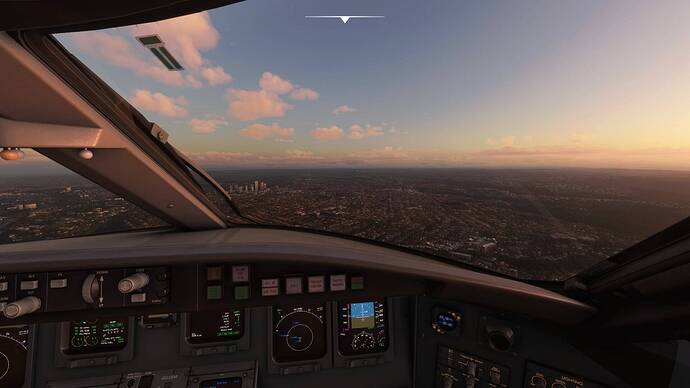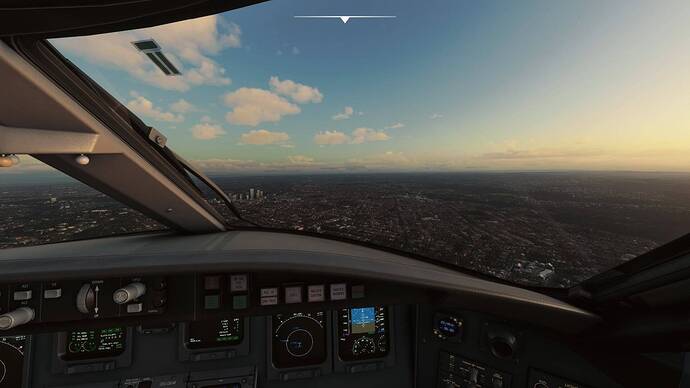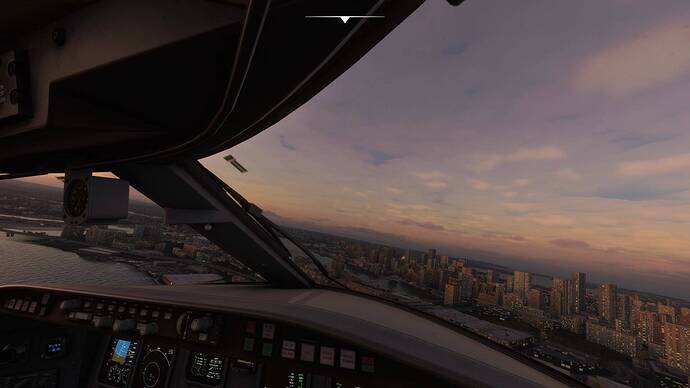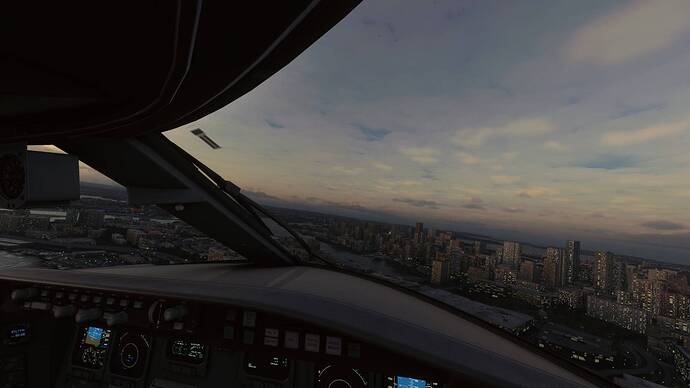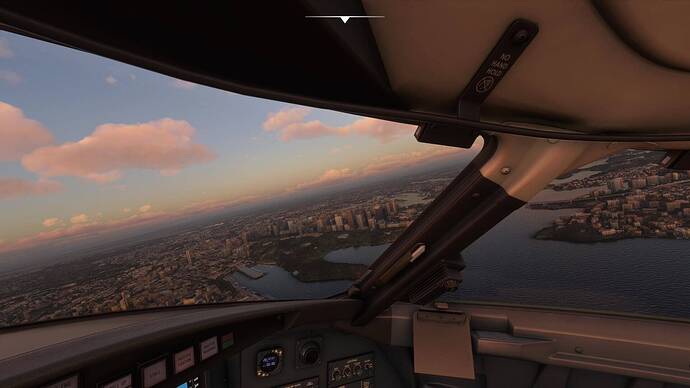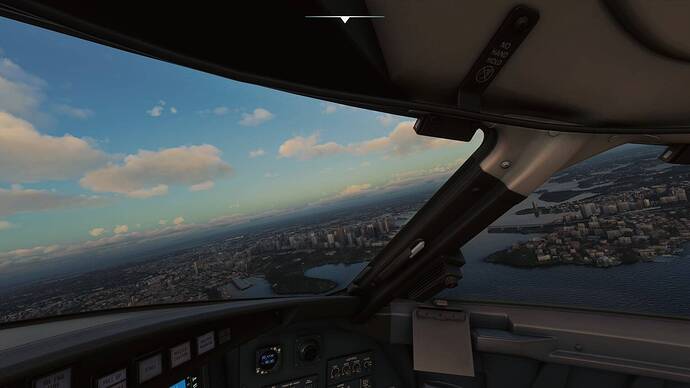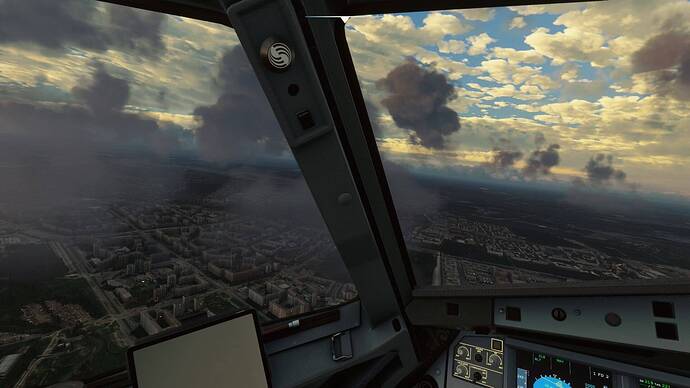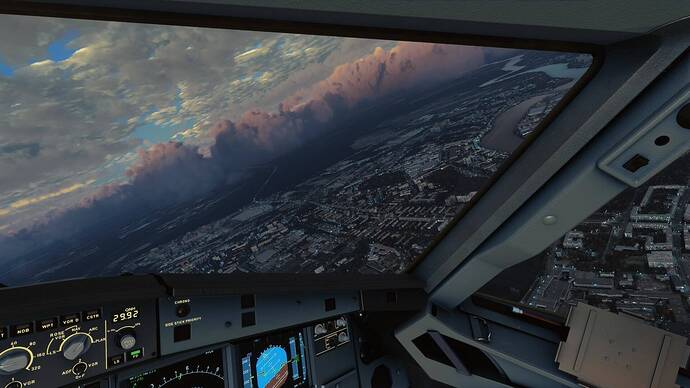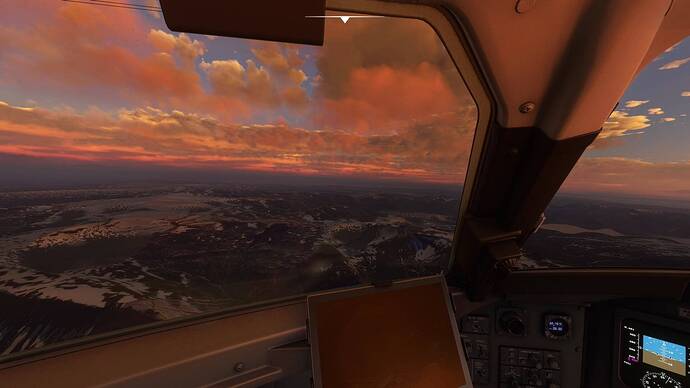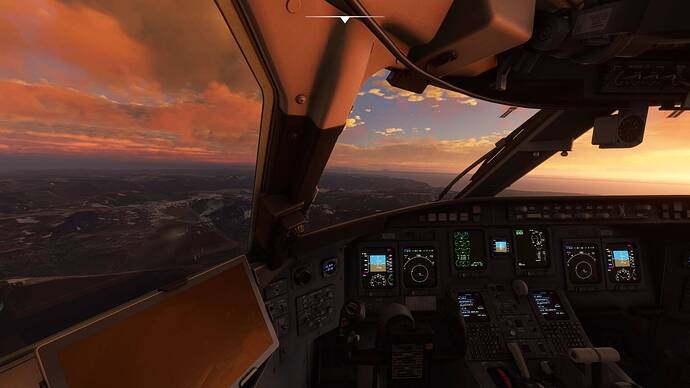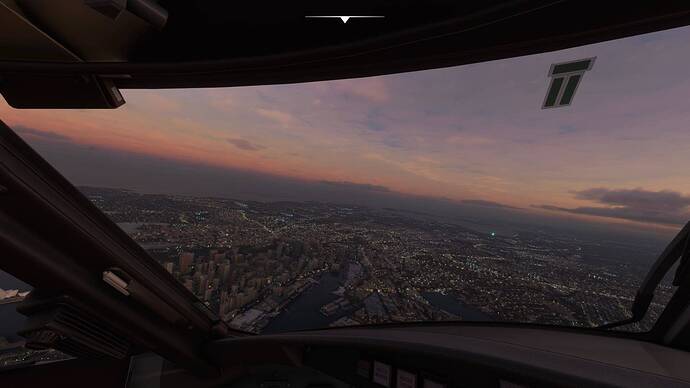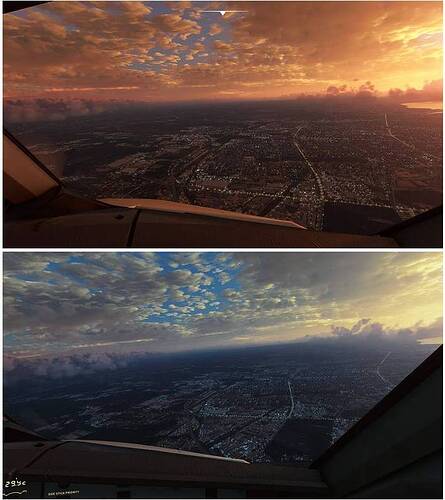Being very GPU limited, through control panel I tried to shift Nvidia’s shader cache onto virtual memory thinking my Pro Evo 980 would be fast enough but quite frankly it isn’t. Approaching new scenery and airports induces a single half a second stutter which while not particularly terrible can ruin the moment at a critical time. If there’s any improvement in performance otherwise I haven’t really noticed so the shaders are definitely going back to the gpu cache.
I saw your post too late and was gonna reply but then saw you had the MS Store version of the game. I heard ReShade does not work on that sadly. If you have nVidia card you can get free GeForce experience and try the filters on that.
You show some nice shades indeed ! But I do wonder.. a lot of things..
-
Does your “cinematic shader” listen to the time slider.. is it aware of MSFS weather settings ?
-
Curious if you have the manpower to maintain this, when DX-12 will come to MSFS.. e.g. bundles, tesselation changes, new domain shaders..
-
What are the performance effects, considering the fact that many GPU’s are quite buzzy with MSFS “Default” shading already, a shading postprocessor would add load.. how much load..
-
how does this fit into the MSFS DX pipeline ? “Injection” ? Do you replace shader code on the fly ? append always ? or do you need to intercept the compile call in DirectX and “inject” your own stuff to replace existing MS/Asobo shaders ?
-
What if color formats, or Constant Buffers are changed, in an SU-update ? Your shader code is bound to the old declarations.. best case, new MS/Asobo features would not be visible, worst case it will result in GPU memory alignment errors and a CTD.
All questions, questions, dear @AlexVengrus, I find your philosophy interesting, but thing is, you show us a nice video, but it is not really clear how your product is installed, and what buttons need to be pressed to achieve results.
Just be careful when using re-shade on games other then this. Some FPS games will ban you for using it, AAPG is just one them that will. You used to be able to use setting that would give you a psuedo wall hack effect, giving you and advantage over you adversaries.
That being said, yeah re-shade can do some amazing things to games.
This is true. Another cheat if inside a dark environment is to play with the FakeHDR slider and you almost get night vision.
I dont play any online multiplayer as I love solo only and I use the above trick in GR Breakpoint as the lighting in that game is horrible.
Did you post the settings you use lately? I likedthem but cant find the thread anymore…
I can’t install ReShade on MSFS 2020 Store version
And I wish I could. Nvidia Ansel is limited, imo
I’d like to set the Brightness and Contrast - Exposure, from 0 to - 4 or - 5 but it goes straight to - 12 when I use the slider
Is there a way to fix this, inside the preset, maybe?
Hi ! As i am one of the contributors of Reshade, i can answer all of your questions:
- Does your “cinematic shader” listen to the time slider… is it aware of MSFS weather settings ?
No, it does not. It cannot be aware of MSFS weather settings - Curious if you have the manpower to maintain this, when DX-12 will come to MSFS… e.g. bundles, tesselation changes, new domain shaders…
No maintaining process to do. Reshade is already compatible with the DX12 API, and you don’t have to update Reshade shaders. When MSFS will use DX12, it will be transparent for Reshade. Reshade’s shaders run post process - What are the performance effects, considering the fact that many GPU’s are quite buzzy with MSFS “Default” shading already, a shading postprocessor would add load… how much load…
It depends on the resolution and the shaders you use. The more important the resolution, or the more complex the shader, the more important the CPU and GPU load. But you can monitor the impact on the statistics tab of Reshade. - how does this fit into the MSFS DX pipeline ? “Injection” ? Do you replace shader code on the fly ? append always ? or do you need to intercept the compile call in DirectX and “inject” your own stuff to replace existing MS/Asobo shaders ?
Reshade injects it’s own methods in the graphic API pipeline, extending them. This allows to apply extra shaders at the end of the rendering process (post process shaders). So it does not interfere with the MSFS shaders, but it can enforce them (for instance, if you use a Reshade sharpening shader, it will enforce the existing MSFS sharpening shader). - What if color formats, or Constant Buffers are changed, in an SU-update ? Your shader code is bound to the old declarations… best case, new MS/Asobo features would not be visible, worst case it will result in GPU memory alignment errors and a CTD.
Maybe in MSFS itself, but certainly not in Reshade. Reshade will not cause CTDs.
Honestly? I don’t perceive much of a difference, but that’s me.
Dear forum participants!
I’m sorry that I didn’t answer for a long time. There was a lot of work in my life. In addition, it takes me some time to write the answer, since I haven’t yet learned English well enough.
I’m grateful to all the participants of the discussion for their attention to this topic!
I express my special gratitude to thalixte for the detailed answer! The opinion of the ReShade contributor is very important for this discussion.
Let me add some of my thoughts about previous posts. I’ll also introduce you to my new ReShade preset in this post.
About ArcanePython931 questions as an addition to thalixte words.
- The lack of a software connection between the ReShade and the simulator atmospheric engine is not a big problem, in my opinion. ReShade is primarily a post effect injector. Working with post effects has a special logic, from my point of view. The main feature of this logic is that the post effect is always made universal. Let me draw an analogy with sound processing in a recording studio. The studio has a special kind of effects called “Mastering effects”. These effects are designed in such a way that their settings can remain relevant regardless to situational changes in the sound. The same is the case with ReShade. ReShade is a kind of mastering effect processor for the simulator graphics, in my opinion. It is possible to customize the ReShade in such a way that its settings are suitable for any time of day, weather or other situational changes in the simulator graphics.
- At the same time, the ReShade has some possibilities for automatic adjustment of shaders depending on the characteristics of the image. In particular, I often use “01B_RT_Correct_Color” shader by prod80, which allows automatic color grading. I created my new ReShade preset based on this shader. This preset simulates a cold blue dawn and dusk for the MSFS2020 with automatic adaptation to color changes caused by the time of day or the weather engine of the simulator. (I also added a number of other shaders for additional balancing of the preset, but the shaders are tuned universally and don’t need situational adjustments.) Now I’m working on the preset and preparing a video about it. I will post the preset and the video when the work is done.
Let me present a number of my screenshots as a preview of the preset. The screenshots are presented in two variants: Default graphics and ReShade graphics. (Sometimes I additionally show a second screenshot of the ReShade graphics). Sorry if the quality of the screenshots is insufficient. I captured the screenshots from my video files that I prepared for the aforementioned video. The planes that I used in the screenshots are Aerosoft CRJ and FlyByWire A320NX.
The level of blue tones in each screenshot is slightly different. Setting the preset is done by simply turning the camera in the cockpit to a specific color area. It’s simple and practical. Unfortunately, the preset has one drawback: after automatic color grading is done, you need to stabilize the colors using the “Freeze” button in the “prod80_01B_RT_Correct_Color” shader settings. Otherwise the colors will constantly change. So, strictly speaking, this is a semi-automatic color grading. But it’s much easier than manually adjusting the color balance through some shader such as “ColorMatrix”, in my opinion. In general, I see great promise in the ReShade shaders that can dynamically and automatically change their parameters depending on the image. I think this can compensate for the lack of a direct connection between the ReShade and the atmospheric engine of the MSFS2020.
- Most ReShade shaders use resources CPU and GPU quite sparingly, in my opinion. My ReShade presets usually consume only a few fps with minimal input lag (despite I’m testing the presets on a fairly old I7-3930K with GeForce RTX2060). I also didn’t notice any errors or CTDs in the work of the MSFS2020 due to the GPU overload. So if you don’t use heavy shaders like some noise reduction shaders, I think there won’t be any problems.
- I have been using ReShade in a variety of flight simulators for many years. As a result, I came to conclusion that ReShade shaders have significant autonomy in relation to a graphics engine of a simulator. Moreover, I could achieve similar shades of the image with using the same ReShade shaders on different APIs. Along with this, it is possible to create a ReShade shader that surpasses the capabilities of a particular graphics engine. Well-known example is the ReShade RayTracing emulation for X-Plane using Marty McFly’s path tracer. Although this shader doesn’t fully simulate RayTracing, it nevertheless significantly exceeds the capabilities of the graphics engine of the X-Plane. Therefore, I don’t think that the evolution of a particular graphics engine can make impossible of ReShade shaders use. In addition, ReShade currently supports modern low-level APIs what thalixte has already mentioned.
About Aviattore7040 questions.
Regarding my guide for MilkyDeveloper’s “ReshadeForUWP”, not so long ago I published a screenshots that prove that the ReShade really works on MS Store version of the MSFS2020 in my case. But as I said earlier, this may not work for some users. Installing ReShade this way is experimental. You can find the screenshots in my topic about the “ReshadeForUWP” program. (I have already published the link to the topic here earlier.) I’m also making a video version of my guide (with some updates). I hope that the video will help to make the installation process clearer and more efficient.
Regarding Ansel or Freestyle, this injector has a specific interface feature: it sliders may jump off at inconvenient values at first. But over time, when you have already run the MSFS2020 many times and worked with several sections of Freestyle presets, some sliders can jump to smaller, fractional values.
Thanks for your elaborate answer.. I now understand ReShade is a filter on the complete end result, not a separate shader for particular topics. A manual setting screen with sliders is involved ?
Don’t overdo it I would say.. I think you’ll need some connection to the weather system for this.. at least the time set. The blue hue can be inappropriate with some sunlight..
You’re changing an evening sky into a morning sky..
Just a little precision: NVIDIA Freestyle uses the same shader compilation engine as Reshade. In fact, it uses the Reshade engine, so you can safely use Reshade, as even NVIDIA drivers use some part of it…
As ArcanePython931 justly remark, there is some problem with sun colors in my current ReShade preset at the moment. There is also some excess of yellow color. But at the same time, each of my screenshots has a different depth and balance of colors as the preset is dynamic and semi-automatic. Please do not draw conclusions from one screenshot. The screenshots number 02, 04, 08, 13, 15 and 17 of my previous post have acceptable balance, in my opinion.
I clarify the main purpose of my current ReShade preset which I mentioned in my previous post. The weather engine of the MSFS2020 is very good. The variability of sky colors has increased since the SU5, so the atmosphere of the simulator is even more beautiful! But default sunrise and sunset colors of the simulator are still bright red. This red colors seems to be overloaded, in my opinion. These colors are different in real life. I created the ReShade preset to solve this problem. So the main goal of my current ReShade preset is the color correction of the sunrise and sunset of the MSFS2020. The blue hue is not a goal, but only one of the results of this correction.
As already mentioned, color correction is carried out semi-automatically in the preset. The level of blue hue depends on the area that the camera is aiming at in the cockpit before manual freeze the correction. From my point of view, the color balance is quite soft without a explicit blue hue in some of my screenshots.
I’m not suggesting that ReShade can act as a weather engine, because attempt to change the sky and clouds colors via post processing can lead to some degradation of the whole image. But I will try to keep this degradation to a minimum in my further improvements of the preset.
I hope that the ability to manual adjust the colors of the sky and clouds will appear in future updates to the simulator. (These capabilities have always been in the custom weather engines like “REX Weather Force” and “xVision” for previous flight simulators.)
Regarding manual setting screen usage. I try to find universal settings for most of the shaders in the preset. But as I said before, the automatic color correction of the “prod80_01B_RT_Correct_Color” shader must be stopped by manually pressing one button in the shader settings. I hope to be able to find a solution to this situation in the future.
About the terminology of my previous post: my screenshots show not only late evening but also early morning. I meant early morning (sunrise) by the word “dawn”. I meant late evening (sunset) by the word “dusk”.
